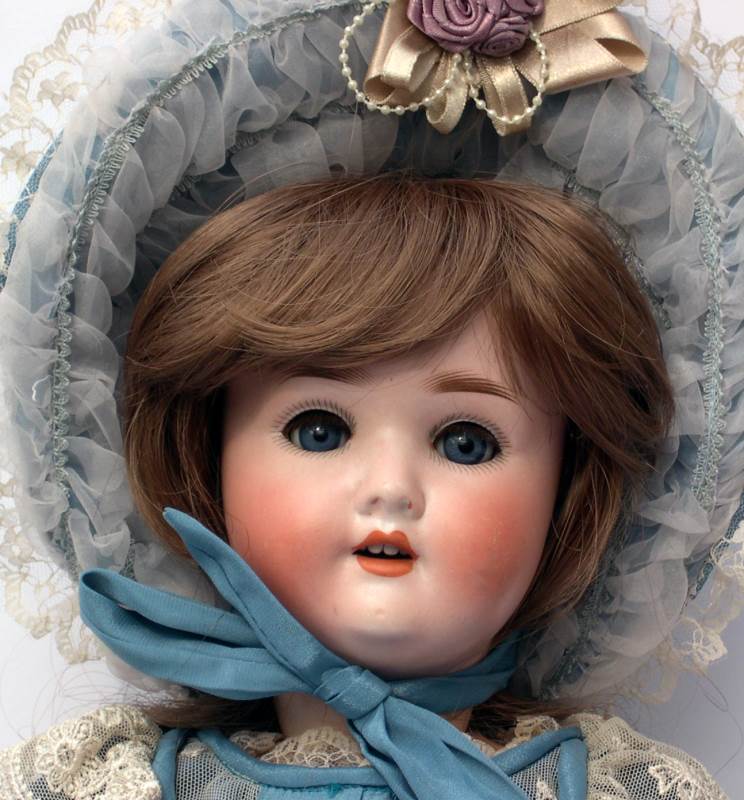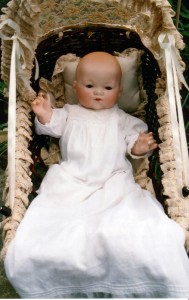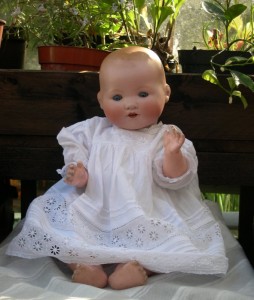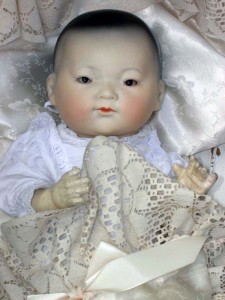 Armand Marseille Dolls & Other Bisque Dolls by Susan Brewer (follow Sue on Twitter @bunnypussflunge)
Armand Marseille Dolls & Other Bisque Dolls by Susan Brewer (follow Sue on Twitter @bunnypussflunge)
Those of us born after the war would have had dolls made from composition, which was a kind of plaster mixed with glue and sawdust, or maybe we had dolls made from the new plastic materials. For those born during or before the war, composition was also a popular material, widely used from the 1930s. However, if we go back a bit, maybe to the time of our grannies or great grandmothers – the late 1800s to the 1920s – we will find ourselves in the magical era of beautiful bisque china dolls. It may be that you were born during the first decades of the twentieth century and so were fortunate enough to own a bisque doll of your own.
Pictured left: Schoenau & Hoffmeister 1906. A pretty girl doll who looks elegant in a lace-trimmed bonnet.
Bisque china dolls are those tranquil faced beauties we see featured on the Antiques Roadshow, with glass eyes, hand-painted features and, often, ‘double-jointed’ limbs. The porcelain used for the faces is unglazed, so it’s matt instead of shiny, hence the ‘biscuit’ finish. It gives a natural look to the face of a doll. The limbs and bodies are made from composition, wood or kid leather, and the ball joints in their wrists, elbows, knees and ankles mean that they can be posed. As the heads were made of fine china they were extremely breakable, and the fact that there are so many still around today just goes to show how much little girls treasured their dolls in those days. They probably only had a few, unlike today’s children who might own dozens of Barbies or baby dolls which are played with for a short while before being discarding. Bisque dolls were loved and cherished – just think of all the stories they could tell us today.
 Pictured left: Armand Marseille 995. This is a more unusual doll by the Armand Marseille Factory. Dating from around late 1920s, she has beautiful brown eyes.
Pictured left: Armand Marseille 995. This is a more unusual doll by the Armand Marseille Factory. Dating from around late 1920s, she has beautiful brown eyes.
Most of the dolls were made in Germany, but some came from France. The French ones were often of superior quality, with enormous lustrous glass eyes, and they tended to be fashion dolls dressed in luxurious fabrics and complicated dress styles featuring pleats, ruffles and plenty of frills. These top of the range ‘chic’ dolls were really only affordable by the richest families, and were made by such companies as Jumeau and Bru. Although nowadays we usually associate bisque dolls with the earlier decades, in 1938, a state visit by King George VI and Queen Elizabeth to France was commemorated by gift of two large dolls on behalf of the children of France to Princess Elizabeth and her sister Princess Margaret Rose. These exquisite dolls came with a spectacular trousseau of 350 items, including garments from major French fashion houses, as well as cribs, tea sets, jewellery, prams, perfume, wardrobes and even a pair of doll-sized sporty Citroens! Today they can be viewed at Windsor Castle.

Pictured right: This is an Armand Marseille 341 ‘My Dream Baby’ – it is the closed mouth version with the solemn expression. An enchanting doll, no wonder so many 1920s’ little girls wanted one.
To return to the late 1800s, by now Germany was forging ahead with doll production – they were more skilled in mass production, and soon were the dominant doll producers. Their dolls were cheaper, too, and so more affordable, and though the quality might not have been as high, the majority of the dolls were still very pretty. Dozens of German factories issued dolls, some concentrating on heads, others on bodies. Amongst the more commonly-found names found – usually bisque dolls bear an incised mark or name on the back of the neck – are Heubach Koppelsdorf, Simon & Halbig, Alt. Beck & Gottschalk, Schuetzmeister & Quendt, Kestner, Schoenau & Hoffmeister, Kammer & Reinhardt and, most frequently, Armand Marseille.

Pictured left: Here is an Armand Marseille 351 ‘My Dream Baby’ featuring an open mouth with two teeth. She looks happier than the solemn version, but both were deservedly popular.
Despite the French-sounding name, Armand Marseille was a German manufacturer whose beautiful girl and baby dolls were deservedly popular. One of the most loved designs was a girl doll with the number 390 on her back. She first came into production in the early 1900s and was still in production in the 1930s. It is amazing how these dolls, all from the same mould, can look so different, just due to the hand-painting of their faces which varied the colouring, shape of the mouth and the thickness of the skilfully painted lashes. Also, the eye and hair colours/styles influenced the doll’s appearance, and as the eye slots were cut in each head separately, the eye size could vary – dolls really had character in those days, unlike today’s plastic dolls turned out in their identical thousands by a machine.
 Pictured right: An Armand Marseille oriental baby
Pictured right: An Armand Marseille oriental baby
Armand Marseille was also responsible for a craze that swept Britain and the Continent during the mid-1920s, when they introduced a baby doll known as ‘My Dream Baby’. To understand the reason for the fad, it’s necessary to understand that before this doll was introduced, the majority of dolls were girl dolls or lady dolls. If a child wanted a baby doll, then a girl doll would have to be wrapped in a shawl, but it never really looked right. The shape was wrong, the doll had lots of hair and a grown up face. My Dream Baby dolls were different – for a start, they were bald-headed with a proper baby face, but in addition, the legs and arms were bent into the positions a baby would use. These dolls had either closed mouths and solemn faces or slightly smiling mouths revealing two tiny lower teeth. A delightful Oriental Dream Baby was available too, as well as a black one. As with the girl dolls, the appearance of these babies varies enormously depending on the painting, body type, eye size and the size of the doll, which can range from tiny babies just a few inches high to very large babies often used as shop window display models. These baby dolls were so popular that the company later made them from composition, well into the 1930s.
 Another prolific company produced dolls marked ‘Heubach Kopplesdorf’, made by Ernst Heubach, a brother-in-law of Armand Marseille. These attractive dolls often had a rather flushed appearance, giving them an ‘English Rose’ appeal, while the girls made by Schoenau & Hoffmeister are usually exquisitely painted with slightly pensive faces. These girls often suit beautiful bonnets and fashionable styles of the early 1900s, with plenty of velvet, floral trims and antique lace.
Another prolific company produced dolls marked ‘Heubach Kopplesdorf’, made by Ernst Heubach, a brother-in-law of Armand Marseille. These attractive dolls often had a rather flushed appearance, giving them an ‘English Rose’ appeal, while the girls made by Schoenau & Hoffmeister are usually exquisitely painted with slightly pensive faces. These girls often suit beautiful bonnets and fashionable styles of the early 1900s, with plenty of velvet, floral trims and antique lace.
Pictured left: Walther & Sohn 125.10, a doll which dresses up well as a more sophisticated lady.
If you are fortunate enough today to own a bisque doll, it is important to try to keep her as original as you can. Thinning wigs can often be disguised by rearranging the hair around the face and placing a bonnet on the head to hide the bald part. If you really feel you must replace the wig then keep the old one safe in a labelled paper bag, and try to buy a mohair or human hair wig from a doll supplier rather than a modern nylon wig. You can gently wipe the face of a bisque doll with a damp cloth, though don’t get water into the eyes, as they are fixed in with plaster of Paris which will dissolve, causing the eyes to fall out. Never put water onto the composition body or limbs as it will remove the surface gloss and paint. If you want to redress an antique doll, natural fabrics such as cotton, lace, muslin or silk look better than modern polyester which never hangs quite right. I often look at my own bisque dolls, just imagining the historical events and developments that they have lived through – they gaze serenely back. I wish that they could speak!





